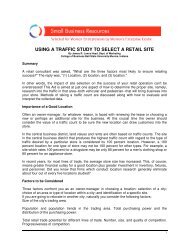Cascade NTFP Regional Profile.pdf - First Nations in British ...
Cascade NTFP Regional Profile.pdf - First Nations in British ...
Cascade NTFP Regional Profile.pdf - First Nations in British ...
Create successful ePaper yourself
Turn your PDF publications into a flip-book with our unique Google optimized e-Paper software.
<strong>Cascade</strong>s <strong>NTFP</strong> <strong>Profile</strong><br />
forest from the <strong>in</strong>tense beetle logg<strong>in</strong>g. The MPB logg<strong>in</strong>g was mentioned as a major<br />
concern for Upper Nicola for many understory species, <strong>in</strong> particular Labrador tea.<br />
Perhaps the most important result from the <strong>in</strong>terviews was the broad consensus that the<br />
land base should be managed for NTFRs. To move from the current situation of m<strong>in</strong>imal<br />
management to active management, major steps will need to be taken. The<br />
overwhelm<strong>in</strong>g importance of the NTFRs to <strong>First</strong> <strong>Nations</strong> means that there should be<br />
leadership com<strong>in</strong>g from the <strong>First</strong> <strong>Nations</strong> <strong>in</strong> terms of how and where to move forward. In<br />
order to make this transition back to deliberate management for these species it would be<br />
germane to consider a keystone approach <strong>in</strong> which steps are taken first for the species of<br />
most importance.<br />
Concern<strong>in</strong>g the commercial use of NTFRs, there were mixed op<strong>in</strong>ions. A number of the<br />
<strong>in</strong>terviewees expressed concern about such a use of these plants. Many said that when<br />
Siska Traditions started bus<strong>in</strong>ess that it made them feel very uncomfortable, however, as<br />
time has passed their thoughts have evolved and now believe <strong>in</strong> the importance of this<br />
type of bus<strong>in</strong>ess as a modern means of cont<strong>in</strong>u<strong>in</strong>g ancient traditions. It appears that if<br />
commercial harvest<strong>in</strong>g is done with<strong>in</strong> appropriate conf<strong>in</strong>es that don’t impact subsistence<br />
harvesters then its growth may be acceptable, especially when driven by communities<br />
with<strong>in</strong> the area.<br />
In order to more fully understand the effects of timber harvest<strong>in</strong>g, fire and other impacts<br />
on NTFRs, it is critical to build our understand<strong>in</strong>g of the NTFR species. Currently there<br />
are two BC Forest Science Program funded research projects underway, one be<strong>in</strong>g led by<br />
the M<strong>in</strong>istry of Forests and Range Research Branch called the Huckleberry Synthesis<br />
Project and the other be<strong>in</strong>g led by Siska Traditions Society called “Measur<strong>in</strong>g Success <strong>in</strong><br />
Manag<strong>in</strong>g for Saskatoon berries and other <strong>NTFP</strong>s”. The former project is develop<strong>in</strong>g a<br />
synthesis of knowledge on huckleberry management from the literature with the goal of<br />
develop<strong>in</strong>g black huckleberry management guidel<strong>in</strong>es. The latter project is a multi-stage<br />
project that <strong>in</strong>volves two experimental cutblocks that will have logg<strong>in</strong>g, prescribed fire<br />
and or prun<strong>in</strong>g treatments along with a control, one of this project’s deliverables is<br />
guidel<strong>in</strong>es for Saskatoon berry, Oregon grape, beaked hazelnut and soopalalie. These<br />
projects have overlapp<strong>in</strong>g research teams and the guidel<strong>in</strong>es produced will be us<strong>in</strong>g a<br />
consistent and accessible format.<br />
Along with the need to understand the impacts on the environment it is also germane to<br />
more fully understand the current and potential benefits of theses species to <strong>First</strong> <strong>Nations</strong><br />
and others. Currently the Heskw’en’scutxe Health Services Society, Siska Traditions and<br />
Tmix w<br />
Research are work<strong>in</strong>g out a project that has the goal of promot<strong>in</strong>g health through<br />
the <strong>in</strong>creased use of wild foods <strong>in</strong> the diet. Many health problems have been l<strong>in</strong>ked with<br />
the move from wild foods to processed foods with <strong>First</strong> <strong>Nations</strong>. It is believed that a<br />
move back to the use of more traditional foods will promote healthier liv<strong>in</strong>g (David<br />
Walkem pers. com 2007).<br />
The Nicola-Similkameen Innovative Forestry Society (NSIFS), <strong>in</strong> conjunction with<br />
T’mixw Research and consultants have developed a predictive mapp<strong>in</strong>g system for the




